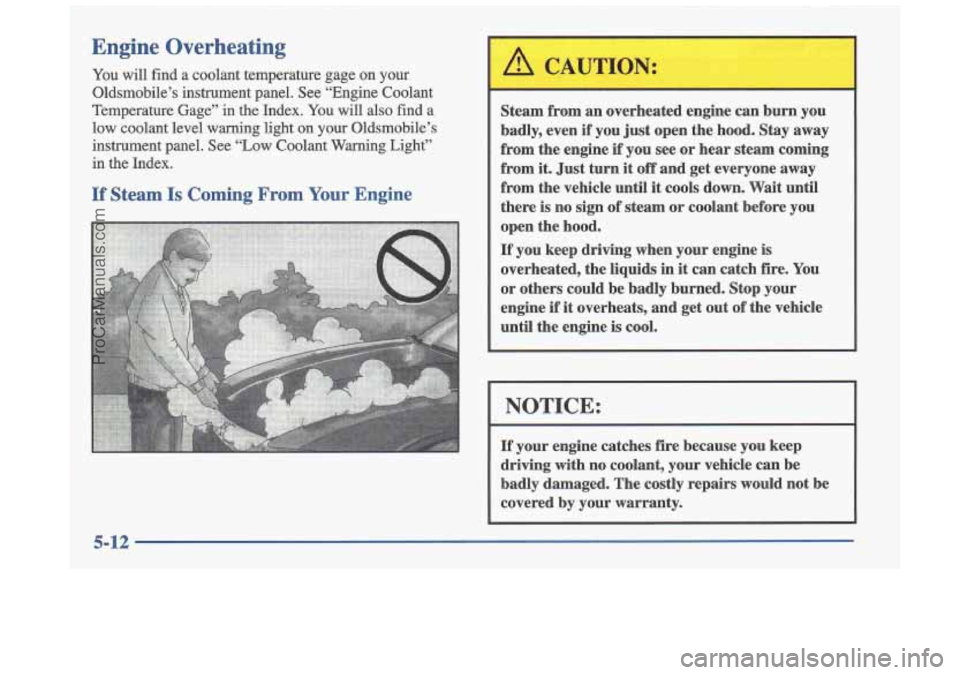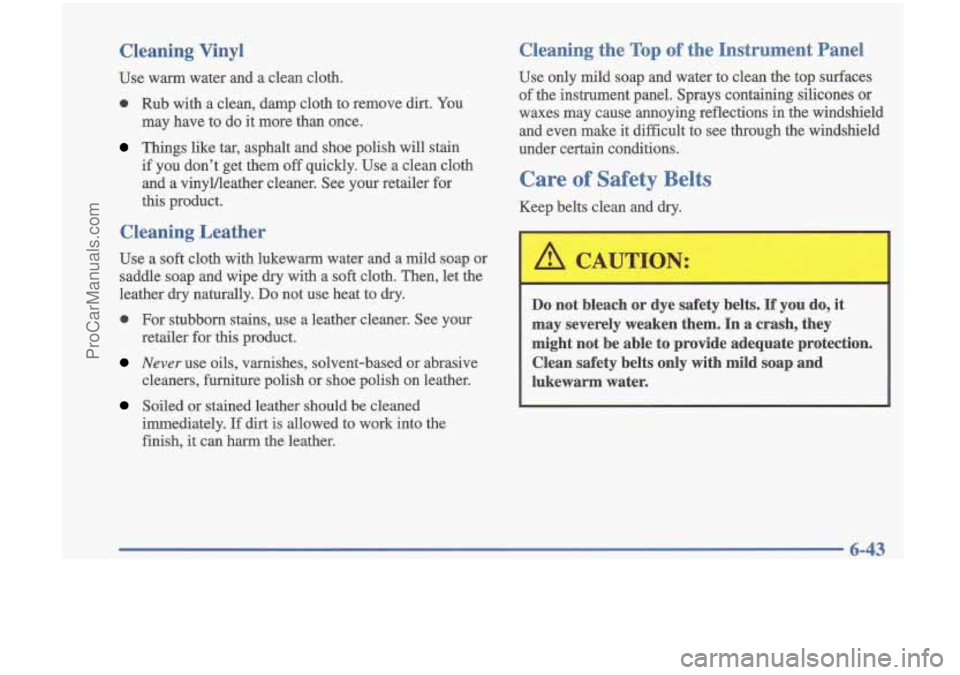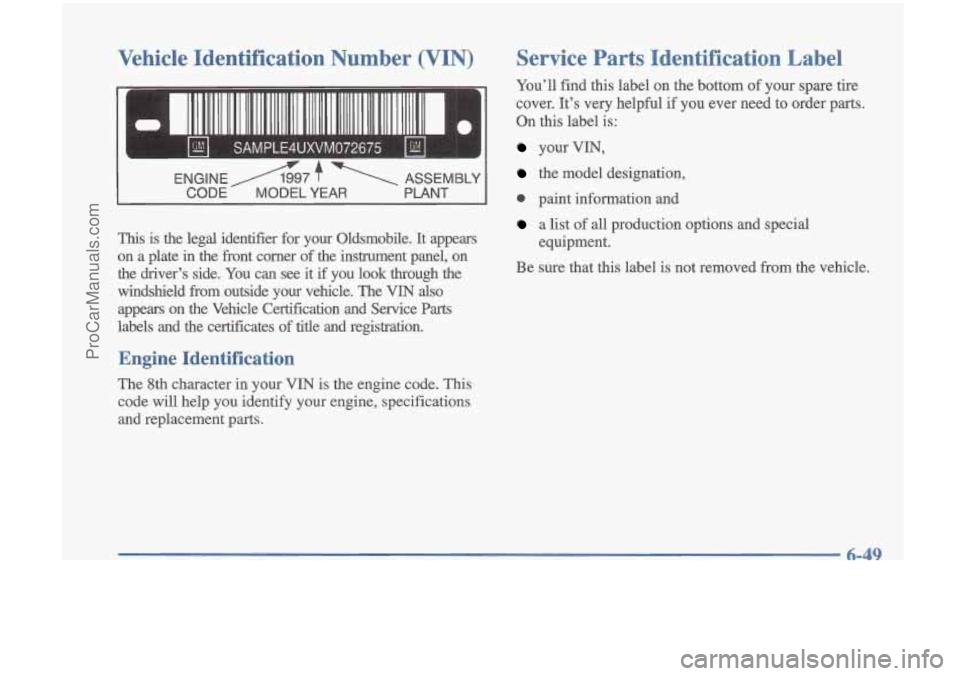1997 OLDSMOBILE CUTLASS instrument panel
[x] Cancel search: instrument panelPage 125 of 353

Heating
On cold days, use FLOOR with the temperature knob all
the way in the red area. The system will bring in outside
air, heat it and send it to the floor ducts.
Your vehicle has heat ducts that are directed toward the
rear seat. Keep the area under the front seats clear
of
obstructions so the heated air can reach the rear
seat passengers.
If your vehicle has an engine coolant heater, you can use
it to help your system provide warm
air faster when it’s
cold outside (0°F
(- 18 O C) or lower). An engine coolant
heater warms the coolant your engine and heating system use to provide heat. See “Engine Coolant
Heater” in the Index.
Defogging and Defrosting Windows
Your system has two settings for clearing the front and
side windows. For each setting, adjust the temperature
control as desired.
To defrost the windows quickly, rotate the temperature
control
knob all the way in the red area. Use
DEFROST and adjust the fan to the highest speed.
To warm passengers while keeping the windows clean,
use DEFOG.
Your vehicle is equipped with side window defogger
vents. The side window defogger vents are located on
the outside of the side instrument panel vents. For
additional side window defogging, rotate the mode
control to VENT, rotate the
fan control to the highest
speed, press A/C and aim the side vents on the
instrument panel to the windows. For increased airflow
to the side windows, close the center vents.
RECIRCULATION will not work in DEFROST and
DEFOG. This is done to prevent recirculation of humid
inside air and allow the system to work properly.
ProCarManuals.com
Page 174 of 353

To tow your vehicle with all four wheels on the ground,
follow these steps:
7 ---
1. Position the vehicle to tow and then secure it.
2. Turn the ignition switch to OFF.
3. Set the parking brake.
4. Remove the following fuses from the left side
instrument panel fuse block:
A) Radio, B) Wiper,
H) Powertrain Control Module and K) Body
Function Control Module, Cluster. This will
prevent your battery
form draining while towing.
See “Instrument Panel Fusle Block-Left” in
Section
6 for location of the fuses.
5. Turn the ignition switch to ACC.
6. Shift your transaxle to NEUTRAL (N).
7. Release the parking brake.
Remember
to replace the fuse once you reach your
destination. To replace the fuse:
1. Set the parking brake.
2. Remove the key from the ignition switch.
3. Replace the fuse.
I NOTICE:
Make sure that the towing speed does not exceed
55 mph (90 km/h), or your vehicle could be
badly damaged.
4-29
ProCarManuals.com
Page 183 of 353

Turn Signals When Towing a Trailer
When you tow a trailer, your vehicle may need a
different turn signal flasher and/or extra wiring. Check
with your Oldsmobile retailer. The green arrows on your
instrument panel will flash whenever you signal a
turn
or lane change. Properly hooked up, the trailer lamps
will
also flash, telling other drivers you’re about to turn,
change lanes or stop.
When towing a trailer, the green arrows on your
instrument panel will flash
for turns even if the bulbs on
the trailer are burned out. Thus, you may
think drivers
behind you
are seeing your signal when they are not. It’s
important to check occasionally to be sure the
trailer
bulbs are still working.
Driving On Grades
I NOTICE:
Do not tow on steep continuous grades exceeding
6 miles (9.6 km). Extended, higher than normal
engine and transaxle temperatures may result
and damage your vehicle. Frequent stops are
very important to allow the engine and transaxle
to cool.
Reduce speed and shift to a lower gear before you start
down a long or steep downgrade. If you don’t shift
down, you might have to use your brakes
so much that
they would get hot and no longer work well.
On a long uphill grade, shift down and reduce your speed to around
45 mph (70 kmk) to reduce the
possibility
of engine and transaxle overheating.
Pay attention to the engine coolant gage.
If the indicator
is in the red area,
turn off the air conditioning (if you
have
this option) to reduce engine load (see “Engine
Overheating” in the Index).
4-38
ProCarManuals.com
Page 199 of 353

Engine Overheating
You will find a coolant temperature gage on your
Oldsmobile’s instrument panel. See “Engine Coolant
Temperature Gage” in the Index.
You will also find a
low coolant level warning light on your Oldsmobile’s
instrument panel. See “Low Coolant Warning Light”
in the Index.
If Steam Is Coming From Your Engine
Steam from an overheated engine can burn you
badly, even if you just open the hood. Stay away
from the engine
if’ you see or hear steam coming
from it. Just turn it
off and get everyone away
from the vehicle until it cools down. Wait until
there
is no sign of steam or coolant before you
open the hood.
If you keep driving when your engine is
overheated, the liquids in it can catch fire. You
or others could be badly burned. Stop your
engine if
it overheats, and get out of the vehicle
until the engine is cool.
I NOTICE:
If your engine catches fire because you keep
driving with no coolant, your vehicle can be
badly damaged. The costly repairs would not be
covered by your warranty.
ProCarManuals.com
Page 227 of 353

If your vehicle is certified to meet California Emission
Standards (indicated on the underhood tune-up label), it
is designed to operate on fuels that meet California
specifications.
If such fuels are not available in states
adopting California emissions standards, your vehicle
will operate satisfactorily on fuels meeting federal
specifications, but emission control system performance
may be affected. The malfunction indicator lamp on
your instrument panel may turn on andor your vehicle
may fail a smog-check test.
If this occurs, return to your
authorized Oldsmobile retailer for diagnosis to
determine the cause of failure.
In the event it is
determined that the cause of the condition is the type
of
fuels used, repairs may not be covered by your warranty.
Some gasolines that are not reformulated for low
emissions contain an octane-enhancing additive called
methylcyclopentadlenyl manganese tricarbonyl
("T);
ask your service station operator whether or not his fuel
contains MMT. General Motors does not recommend the
use of such gasolines. If fuels containing MMT are used,
spark plug life may be reduced and your emission
control system performance may be affected. The
malfunction indicator lamp on your instrument panel
may turn on.
If this occurs, return to your authorized
Oldsmobile retailer for service. To
provide cleaner
air, all gasolines in the United States
are now required to contain additives that will help
prevent deposits from forming in your engine and fuel
system, allowing your emission control system
to
function properly. Therefore, you should not have to add
anything to the fuel.
In addition, gasolines containing
oxygenates, such as ethers and ethanol, and
reformulated gasolines may be available in your area to help clean the air. General Motors recommends that you
use these gasolines if they comply with the specifications described earlier.
s
NOTICE:
Your vehicle was not designed for fuel that
contains methanol. Don't use it. It can corrode
metal parts in your fuel system and also damage
plastic and rubber parts. That damage wouldn't
be covered under your warranty.
6-4
ProCarManuals.com
Page 233 of 353

Engine Oil
CHECK
OIL
If the CHECK OIL
light on the instrument
panel comes on, it
means you need to
check your engine oil level right away.
For more information, see “Check Oil Light” in the
Index. You should check your engine
oil level regularly;
this is an added reminder.
It’s
a good idea to check your engine oil every time you
get
fuel. In order to get an accurate reading, the oil must
be
warm and the vehicle must be on level ground.
The engine oil dipstick
handle is yellow ,and
located on the front of
the engine.
Turn off the engine and give the oil a few minutes
to drain back into the oil pan.
If you don’t, the oil
dipstick might not show the actual level.
ProCarManuals.com
Page 266 of 353

Cleaning Vinyl
Use warm water and a clean cloth.
0 Rub with a clean, damp cloth to remove dirt. You
Things like tar, asphalt and shoe polish will stain
may have
to
do it more than once.
if you don’t get them off quickly. Use a clean cloth and a vinylfleather cleaner. See your retailer for
this product.
Cleaning Leather
Use a soft cloth with lukewarm water and a rnild soap or
saddle soap and wipe
dry with a soft cloth. Then, let the
leather dry naturally. Do not
use heat to dry.
0 For stubborn stains, use a leather cleaner. See your
Never use oils, varnishes, solvent-based or abrasive
retailer
for this product.
cleaners, furniture polish or shoe polish on leather.
Soiled or stained leather should be cleaned
immediately.
If dirt is allowed to work into the
finish,
it can harm the leather.
Cleaning the Top of the Instrument Panel
Use only mild soap and water to clean the top surfaces
of the instrument panel. Sprays containing silicones or
waxes may cause annoying reflections in the windshield
and even make it difficult
to see through the windshield
under certain conditions.
Care of Safety Belts
Keep belts clean and dry.
Do not bleach or dye safety belts. If you do, it
may severely weaken them.
In a crash, they
might not be able to provide adequate protection. Clean safety belts
only with mild soap and
lukewarm water.
- - . ~- ~~ ~ ~ ~~ -~ -~ ~~ __ ~=
I
6-43
ProCarManuals.com
Page 272 of 353

Vehicle Identification Number (VIN)
ENGINE A7 f ASSEMBLY
CODE MODEL YEAR PLANT
This is the legal identifier for your Oldsmobile. It appears
on a plate in the front corner
of the instrument panel, on
the driver’s side. You can see it
if you look through the
windshield from outside your vehicle. The
VIN also
appears on the Vehicle Certification and SerVice Parts
labels and the certificates of title and registration.
Engine Identification
The 8th character in your VIN is the engine code. This
code will help you identify your engine, specifications
and replacement parts.
Service Parts Identification Label
You’ll find this label on the bottom of your spare tire
cover. It’s very helpfbl
if you ever need to order parts.
On this label
is:
your VIN,
the model designation,
0 paint information and
a list of all production options and special
equipment.
Be sure that this label is not removed from the vehicle.
6-49
ProCarManuals.com